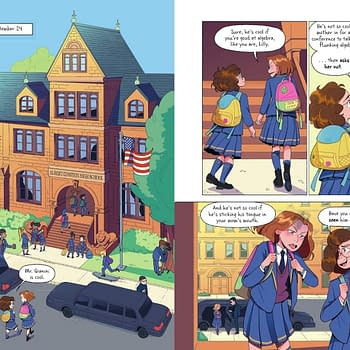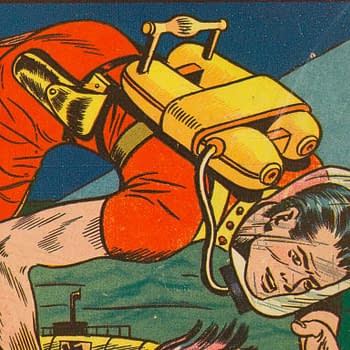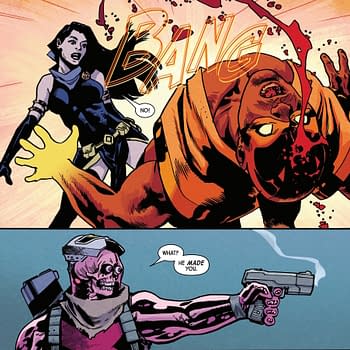Posted in: Comics, Recent Updates | Tagged: Adrian Syaf, Babs Tarr, batgirl, Batman, Batman: Year One. Batman: The Animated Series, Brenden Fletcher. auteur theory, cameron stewart, Comics, dc comics, entertainment, gail simone, greg rucka
Auteur Theory, Attitude, And Visual Style In Greg Rucka's New Gotham
By Bart Bishop
The tide is changing at DC Comics. Ever since the New 52 revamp in 2011, there's been a sustained "House Style" across the line in both aesthetic and narrative tone. The Batman franchise, in particular, has suffered from a massive amount of books that are nearly interchangeable in look and content. One that has stood out in storytelling is Gail Simone's Batgirl. Picking up from her pre-52 handling of Barbara Gordon with Birds of Prey, she's carried the character forward as a compassionate and intelligent crime fighter with a uniquely feminine voice. Still, the art by Adrian Syaf was still nearly indistinguishable from other Batman contributors. That's about to change with the arrival of Babs Tarr with Batgirl #35 (accompanied by co-writers Cameron Stewart and Brenden Fletcher) in October.
Dubbed the "hipster Batgirl", this sassy new take is influenced by indie comics and an outside industry, in this case Tarr's background in fashion design. Although it's presumptuous to pronounce just yet, this run appears to be so specific in its authorial voice and collaboration between writer and artist that it may qualify as what Douglas Wolk, comic book critic and philosopher, calls auterism in his Reading Comics, a concept borrowed from film theory. "This style-first mandate," he explains, "means that [a comic's] primary value for their readers is as the work of their creator's hands" (31). Along with Becky Cloonan on Gotham Academy and the out-there twists of Arkham Manor, it looks like DC is welcoming in more sui generis creators on their most popular character, but this isn't the first time the major corporation has looked outside the box to spice up their most popular character. In the wake of the "No Man's Land" storyline that ran from late 1998 to early 2000, the Batman titles were in need of a fresh start, and that came with Greg Rucka, an newcomer to comics, and his collaboration with artist Shawn Martinbrough and colorists WildStorm FX on Detective Comics is a prime example of the auteur theory applied to the sequential art medium.
Dominated for nearly a decade by crossovers and events, ranging from "Knightfall" to "Contagion" to "Cataclysm" and more, the ubiquitous character had run out of steam from a narrative point of view. Enter Rucka, the crime novelist that had already made a splash with his Atticus Kodiak detective series and Whiteout graphic novel from Oni Press. Coming on at the tail end of "No Man's Land", he was given the reins of flagship title Detective Comics and stayed onboard for two and a half years. Although the title would eventually see crossover events like "Officer Down" and "Bruce Wayne: Murderer/Fugitive" interfere with the storytelling flow, Rucka's first year from issue #742 in March 2000 to #753 in February 2001 was a fresh take without obstruction. Awarded creative freedom and artistic synergy with regular artist Shawn Martinbrough and colorists WildStorm FX, 'Tec was reinvigorated in both content and bearing, with a new logo and distinctive dichromatic color scheme that lasted the duration of Rucka's run.
This new voice and new look, dubbed "New Gotham" after the rebuilding of the city, restored the character back to his hard-boiled roots, taking equal inspiration from the Paul Dini/Bruce Timm The Animated Series and the classic film noir tropes of Frank Miller and David Mazzucchelli's Year One while adding a new element of verisimilitude. This is no more apparent than in the eight-issue run from #743-750, collected in Batman: Evolution, that distills everything Rucka, Martinbrough and WildStorm FX were hoping to accomplish into a taut, provocative storyline.
Although issue #742 serves as an introduction to the new status quo, #743 is more Rucka's mission statement as he introduces the threat of Whisper A'Daire and her master Ra's Al Ghul, demonstrating how this take on the latter character will be more international terrorist than Bond villain-esque pulp super villain. Batman himself is introduced in a dynamic blending of visual and prose storytelling as he fights the five new crime families that have divided up Gotham across five days and one page. Immediately it's clear how WildStorm FX's coloring, consisting of shades of grays and reds, will function, not only giving the book a unique style but a motif that has Batman's costume bleeding into the world around him with the reds used to highlight action set pieces, and a thematic tie that shows the world in less black and whites and more the moral gray area in between.
This conflict with A'Daire and Al Ghul serves as bookends for Rucka's first year, with a one-shot focusing on Renee Montoya and a two-parter, "Urban Renewal" showing the conflict between the "Deezees", people that left Gotham during No Man's Land, and people that stayed, establishing Rucka's take on the GCDP and their relationship with Batman. The handling of the weird in the Al Ghul bits, with a substance that transforms people into monstrous animals being distributed as a street drug, shows Rucka's devotion to grounding the proceedings with practical parallels.
And grounding is what Rucka does, cementing his auteristic cadence that this will be a police procedural book above all else, clearly differentiating itself from the more superheroic Batman title. This is what Wolk describes as "the sole or chief creative control of a single person of significant skill," as while there is truly a collaboration here, it's all at the behest of Rucka's tone and animas (31). There's the aforementioned conceptualizing of the fantastic in real-world terms with the villains, but the heroes are fleshed out in a functional sense as well. Functional is the key here, because there's a difference between complexity, darkness and realism.
Miller's prose has a cynicism and grimness to it with figures of authority corrupt to the point of perverse decadence and criminals speaking in broken, mad slang that permeates Year One in darkness, but it's still a hyper-reality of microcosmic urban decay, a pre-Giuliani New York infested with and crumbling under the weight of crime. With Year One Gordon is the only good cop, but under Rucka's tenure he creates a throughline of believability through complexity with the entire force as competent and trustworthy but diverse and vast, adding new characters such as Hardback Bock and Crispus Allen and focusing on veterans like Renee Montoya. It's all summed up in how Gordon refers to himself and his people as police, as in "We're police" rather than "the police." This is a consistent signifier through his run, spilling over into Gotham Central (2003-2006), showing them as a unified, if exclusionary, force that appreciates Batman from a distance but never truly accepts him as one of them.
Batman, and Bruce Wayne, is codified under Rucka's keyboard as a brilliant detective and taskmaster but one that is aloof and a loner. Miller's Batman straddles a tension inherent in the contemporary take on the character that starts a one-man war but quickly assembles soldiers. He values and craves help from Gordon and Harvey Dent in Year One, and furthermore gratefully accepts the help of Carrie Kelley's Robin in The Dark Knight Returns. Rucka, however, takes a loose thread from the 1990s, one started in "Knightfall" when Bruce doesn't ask Dick Grayson to take over as Batman after the former's back is broken by Bane and continued in "No Man's Land" when he sends his many allies away only to reluctantly accept their help later, and highlights it as a defining trait.
This is a Batman without sidekicks, with even Alfred being absent due to his time away with Tim Drake at boarding school, his only ally the hacker Oracle who is never in the field or in danger. Only later in the run does Batman train Sasha Bordeaux, Bruce Wayne's imposed bodyguard, to fight crime but she's a grown woman and already trained and experienced. Rucka has little patience for the younger sidekicks. His Batman is mostly humorless and driven, although there is an oddly tender moment during "Dependence" when he comforts Whisper A'Daire in withdrawals from her serum, musing, "Ra's. You're a fool. Did you really think you could control it? Addiction is more powerful, more terrifying, than you or I could ever be." A telling moment, and perhaps a self-conscious one for a man dressed like a bat that needs his never-ending battle against criminals.
The aegis of Martinbrough is what ties Rucka's run together as a truly unified front of auteristic vision, style and resonance, three required traits according to Wolk by way of Andrew Sarris's landmark 1962 essay "Notes on the Auteur Theory in 1962" with caveats from Pauline Kael, both noted film critics. Martinbrough's sparse lines and sharp edges are reminiscent of the Bruce Timm-designed The Animated Series, not a coincidence considering Rucka's episodic storytelling coincides with the show's narrativity. The show originally ran from 1993 to 1995 but had recently been revived from 1997 to 1999 as The New Batman Adventures.
The new show maintained the earlier version's Art Deco axiom but tweaked the costume designs of the characters, switching Batman in particular from blue and gray to black and gray, with the classic black bat symbol minus the yellow moon on his chest, like the Golden Age Batman and Year One. The New Batman Adventures had a colder, more brooding title character, a clear influence on Rucka along with the costume design, but the clearest Year One influence is the utility belt, now boxy pouches reminiscent of a soldier's stocky equipment rather than the sleek, utilitarian look made famous by the classic comics and Tim Burton's movies. New Gotham's look under Martinbrough's pen is also more reminiscent of Year One's Ur-City facade, while WildStorm FX's coloring is a mimetic appropriation of that same book's filtered gray and tan visual stamp. Finally, the new logo is big and bold, with striking font and clean bars and boxes that create a distinct brand and feel, complementing the harsh pragmatism of the stories and characters.
Although it's yet to be seen whether or not the work of Tarr, Stewart and Fletcher on Batgirl will be as groundbreaking as Rucka, Martrinbrough and WildStorm FX on Detective, it's clear that long-lasting characters like Batman thrive when the creators are given the freedom to experiment and emphasize their sensibilities over the status quo.
Editor and teacher by day, comic book enthusiast by night, Bart has a background in journalism and is not afraid to use it. His first loves were movies and comic books, and although he grew up a Marvel Zombie he's been known to read another company or two. Married and with a kid on the way, he sure hopes this whole writing thing makes him independently wealthy someday. Bart can be reached at bishop@mcwoodpub.com.



















